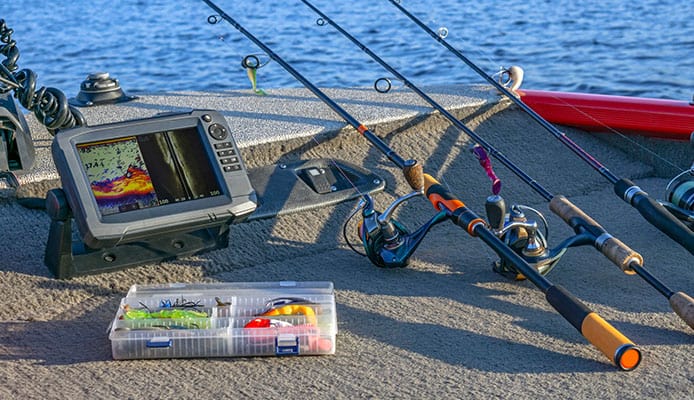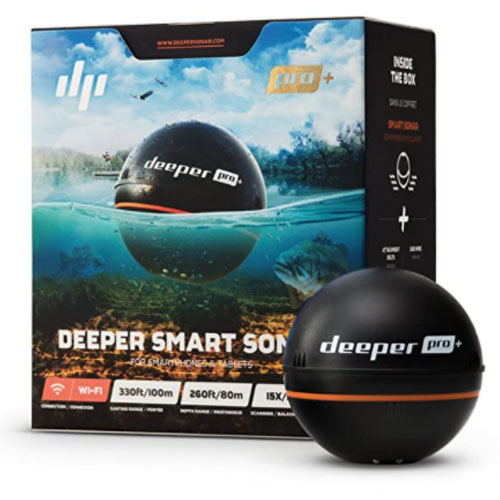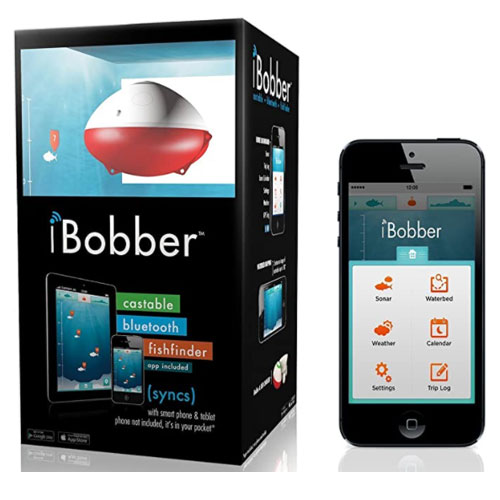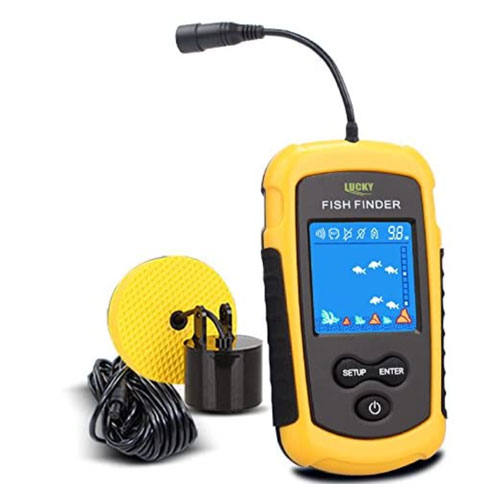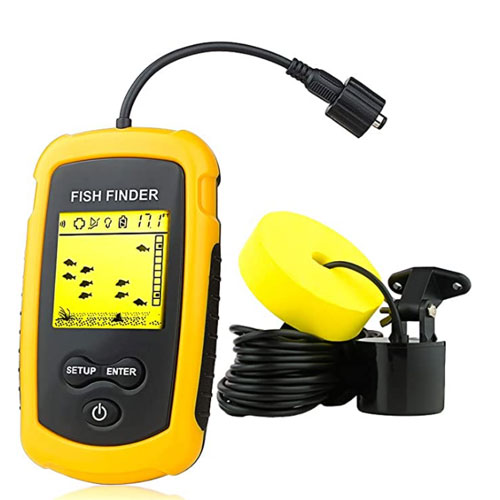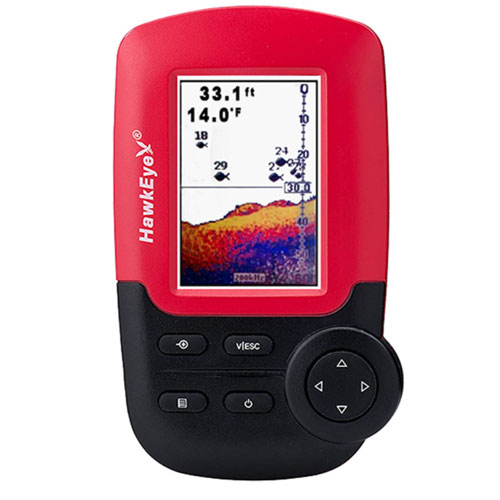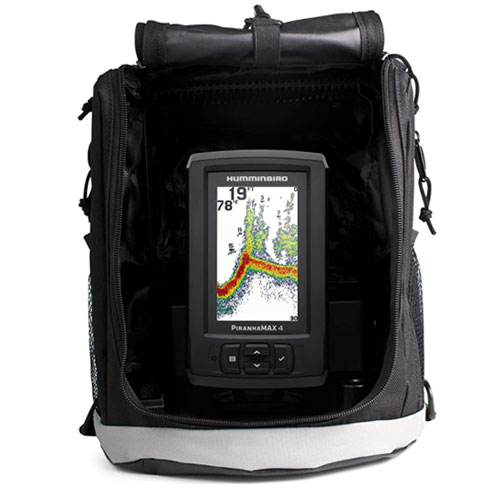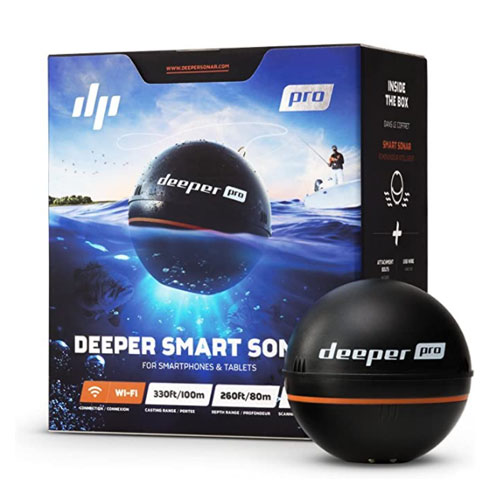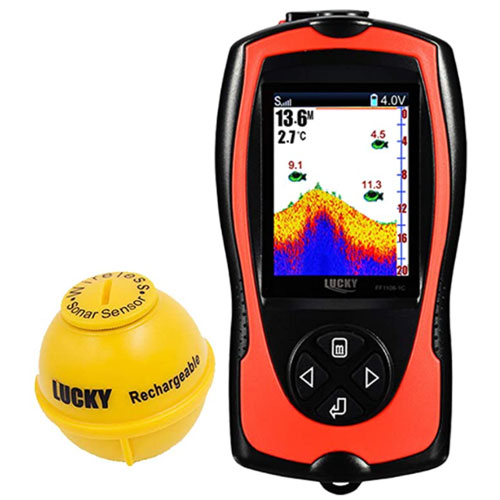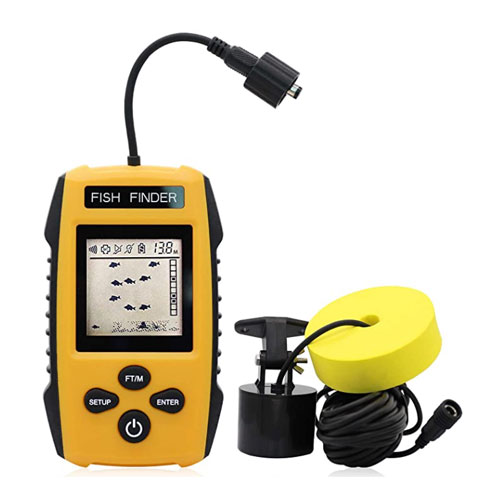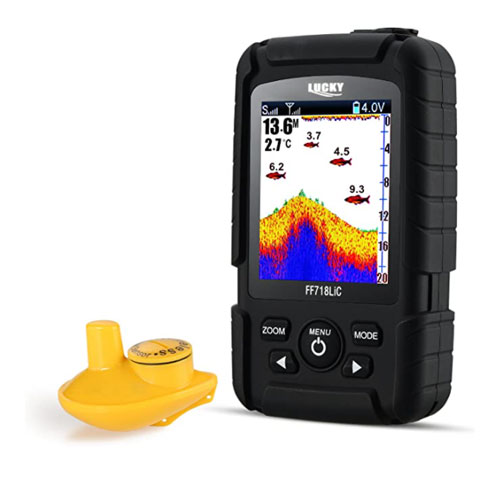-
1.
-
2.
-
3.
-
4.
-
5.
If you’re always looking for new and exciting fishing locations, you need a fish finder that can follow your every move. Traditional fish finders don’t cut it here, since they need to be permanently installed on your boat. However, the best portable fish finder will allow you to easily track fish in every situation – whether you’re on the shore, cruising the lake, or fishing through the ice.
Choosing a good portable fish finder comes down to several things – its range, sonar performance, information it shows, and, of course, portability. To help you make the right choice, this article will explore all the best handheld fish finders currently on the market so you can track fish easily and maximize your catch every time.
OUR TOP PICK
Deeper Pro+ Smart Sonar Portable Fish Finder
- What Makes This Handheld Fish Finder Stand Out
- Castable design that can be used on and off the boat
- Syncs to your phone using WiFi (very stable connection)
- Fast refresh rate for a true real-time image (15x per second)
- Shows depth, temperature readings, and bottom contour
- Easy to use app for both Android and iOS
- Built in GPS
Best For: Casting In The Water
Range: 260 feet
Frequency: 290 and 90 kHz
Weight: 3.5 ounces
Dimensions: 2.55 inches (diameter)
Display Diagonal: Smartphone Screen
Scanning angle: 15° or 55°
GPS: Yes
Battery: Rechargeable
Runtime: 4 to 6 hours
EDITORS CHOICE
ReelSonar iBobber Bluetooth Portable Fish Finder
- What Makes This Handheld Fish Finder Stand Out
- Compatible with smartphones, tablets, and smart watches
- Smart sync Bluetooth connection with a 100-foot range
- High-capacity battery with great runtime (10+ hours)
- Detailed trip log with date, time, location, and fish info
- LED beacon makes the bobber easily visible in the water
Best For: Portability
Range: 135 feet
Weight: 1.58 ounces
Dimensions: 3 x 3 x 3 inches
Display Diagonal: Smartphone Screen
GPS: Yes
Battery: Rechargeable
Runtime: 10+ hours
BEST VALUE
Lucky FF1108-1 Handheld Portable Fish Finder
- What Makes This Handheld Fish Finder Stand Out
- Fish alarm with information about depth and location
- Compact handheld unit with a nice color display
- Four AAA batteries for up to 5 hours of runtime
- 25-foot cable on the transducer for a better range
- Excellent scanning depth (328 feet at 45°)
Best For: Ease of Use
Range: 328 feet
Frequency: 200 kHz
Weight: 1.1 pounds
Dimensions: 5.9 x 3.9 x 3.9 inches
Scanning angle: 45°
GPS: No
Battery: 4 x AAA
Runtime: 4 to 5 hours
Venterior VT-FF001 Portable Fish Finder
- What Makes This Handheld Fish Finder Stand Out
- BackLight mode for easier use in the night
- Battery-save mode greatly prolongs the runtime
- Indicator for rocks and weed on the bottom
- Simple design and easy to use
- 2-year warranty coverage if you have any issues
Best For: Adjustable Transducer Sensitivity
Range: 328 feet
Frequency: 77/200 kHz
Weight: 15.2 ounces
Dimensions: 9.6 x 2.2 x 5.9 inches
Scanning angle: 45°
GPS: No
Battery: 4 x AAA
Runtime: 4 to 5 hours
Hawkeye Fishtrax 1C Portable Fish Finder
- What Makes This Handheld Fish Finder Stand Out
- VirtuView HD display makes reading incredibly easy
- LED backlight makes use easier in low-light conditions
- Sonar sensor is safe to troll behind your boat
- Audible fish alarm when you come across activity
- FishID function for recognizing different fish species
Best For: Trolling
Range: 240 feet
Frequency: 83/200 kHz
Weight: 10.2 ounces
Dimensions: 6 x 3 x 2 inches
Display Size: 2 x 1.6 inches
Scanning angle: 14° or 26°
GPS: No
Battery: 4 x AAA
Runtime: 5 hours
Humminbird Piranhamax 4 PT Portable Fish Finder
- What Makes This Handheld Fish Finder Stand Out
- Maximum scanning depth of up to 600 feet
- Dual-beam operation for wide and narrow scanning
- FishID+ function shows different fish species
- LCD color display with a 4.3-inch diagonal
- Powerful 7Ah battery with a charger included
Best For: Image Quality
Range: 320ft (28°) to 600ft (16°)
Frequency: 200/455 kHz
Weight: 2.5 pounds
Dimensions: 3.91 x 7.34 x 3.62 inches
Display Diagonal: 4.3 inches
Scanning Angle: 16° or 28°
GPS: No
Battery: Rechargeable (7Ah)
Deeper PRO Smart Sonar Portable Fish Finder
- What Makes This Handheld Fish Finder Stand Out
- Excellent for ice fishing or staying on the shore
- Shows a detailed bathymetric map of the bottom
- 3.5-ounce weight allows you to cast it far away
- Mobile phone app for controlling functions and operation
- Shows useful info like fish size, water depth, and temperature
Best For: On-Shore Fishing
Range: 330 feet (horizontal), 260 feet (depth)
Frequency: 90/290 kHz
Weight: 3.5 ounces
Dimensions: 2.55 inches (diameter)
Display Diagonal: Smartphone Display
Scanning Angle: 15° or 55°
GPS: No
Battery: Rechargeable
Runtime: 4 to 6 hours
Lucky FF1108-1C Portable Fish Finder
- What Makes This Handheld Fish Finder Stand Out
- 90° beam angle picks up everything around your boat
- Displays fish size, depth, water temperature, and bottom contour
- Rechargeable Lithium battery with an included USB charger
- Memorizes all your settings so it's very easy to use
- Works well in both high and low temperatures (14°F to 122°F)
Best For: Wide Beam Scanning
Range: 196 feet (horizontal), 147 feet (depth)
Frequency: 125 kHz
Weight: 7.94 ounces
Dimensions: 5.31 x 2.76 inches (handheld)
Display Diagonal: 2.4 inches
Scanning Angle: 90°
GPS: No
Battery: Rechargeable (3.7V Lithium)
Runtime: 4 hours (handheld), 10 hours (transducer)
Ricank Contour Readout Portable Fish Finder
- What Makes This Handheld Fish Finder Stand Out
- Sonar sensor picks up everything between 3 and 328 feet
- Display comes with a backlight for easier reading at night
- Transducer is safe to use on ice or fixed to a boat hull
- Float on the transducer cable prevents it from sinking
- Five sensitivity modes so it doesn’t pick up false signals
Best For: Ice Fishing
Range: 328 feet
Frequency: 200 kHz
Weight: 1.25 pounds
Dimensions: 10.8 x 6.9 x 2.6 inches
Scanning Angle: 45°
GPS: No
Battery: 4 x AAA
Runtime: 4 to 5 hours
LUCKY FF718LiC Portable Fish Finder
- What Makes This Handheld Fish Finder Stand Out
- Works equally well in both fresh and saltwater
- Wide 90° beam coverage with 147ft max depth
- 2.8-inch display with three colors for easy reading
- Shows approximate fish size as well as depth
- Lithium cell rechargeable battery with excellent runtime
Best For: Fresh and Saltwater Fishing
Range: 328 feet (horizontal), 147 feet (depth)
Frequency: 125 kHz
Weight: 6.7 ounces
Dimensions: 5.04 x 2.76 x 1.18 inches
Display Diagonal: 2.8 inches
Scanning Angle: 90°
GPS: No
Battery: Rechargeable
Runtime: 5 to 8 hours
How To Choose The Best Portable Fish Finder – Buying Guide
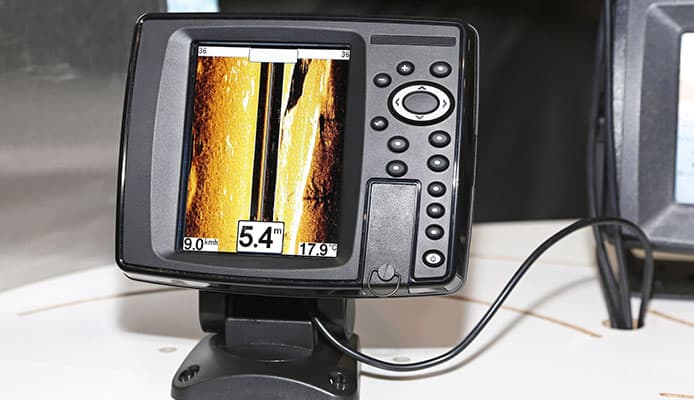
Display Size and Resolution
The display of your fish finder needs to show you all the intricate detail that the sonar picks up. Because of this, it’s ideal to get a fish radar with a large color LCD screen. Many modern fish finders use the screen on your smartphone which might be an even better option.
Wireless or Wired Connection
As you’ve had the chance to see, some fish finder portable models come with transducers that are wired to the handheld, while others are completely wireless. The advantage of wired handheld fish finders is lower price and often steadier signal, while wireless fish finders are more comfortable to use as you can control them via WiFi or Bluetooth from your phone.
Portable vs Castable Design
A classic portable unit comes with a handheld and a wired transducer that you drop into the water. On the other hand, a true castable fish finder is tied to a fishing line and cast far into the water because it works completely wirelessly.
Related Review: Castable Fish Finder
Weight
For easy carrying, your handheld fish finder should be as lightweight as possible. Unlike standard or kayak fish finders, portable models often weigh less than 10 ounces which is why they are perfect for taking anywhere.
Related Review: Kayak Fish Finder
Transducer
This is perhaps the most important part of your fish finder, as it’s responsible for sending and picking up signals that detect the fish in the water. While all of the models we’ve featured have good transducers, it’s still worth paying attention to the cone angle, frequency, and other factors.
Cone Angle
The cone angle is the angle at which fish detector transducers emit the sound waves. A wider angle provides better coverage, while a narrow angle is more concentrated and scans deeper. It’s best if your new fish finder has a dual-beam sonar that covers both of these.
Frequencies
A higher-frequency sonar sends more waves in the water and provides you with more detail. For optimal performance in both deep and shallow water, a frequency of around 200kHz is ideal.
Power
Every fish finder you buy comes with a power draw measured in watts. While you don’t have to worry too much about this, it’s good to know that higher wattage makes reading faster and works better if you’re fishing in deep water.
Water Protection
In most cases, water and technology don’t mix well (especially when saltwater fishing). This goes for lower-end fish finders too, so we advise that you get a unit that is waterproof or at least water-resistant and won’t get damaged by occasional splashing.
GPS Option
A GPS can be a nice addition to the fish finder, as it allows you to mark your favorite spots, draw maps, and create waypoints. However, this option can raise the price significantly so it’s up to you whether you need it or not.
Hull and Transom Mounting
Even though all of these models focus on portability, it’s a plus if you can permanently install them if you decide to do so. While this can’t be done with wireless castable units, more traditional fish finders come with bolts and nuts to secure the transducer to the hull or transom.
FAQs
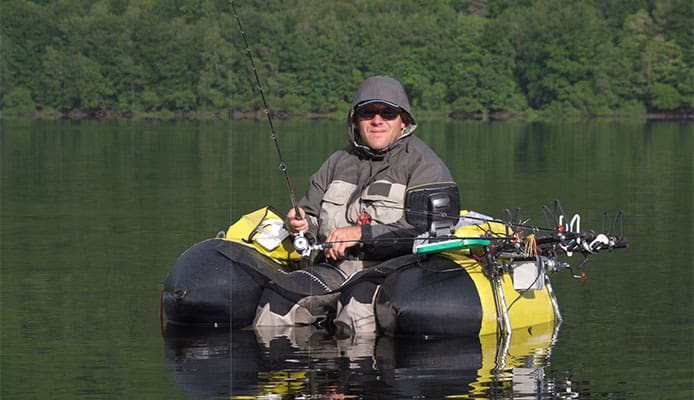
Q: What Is A Portable Fish Finder?
It’s a fish finder that you can carry around and use without installing it on the boat. While most models usually come with a handheld unit and a transducer on a cable, some more sophisticated designs feature just a castable transducer that connects to your smartphone.
Q: Is It Better To Get A Portable Or Castable Fish Finder?
These two types often overlap, as you can usually cast the transducer of a portable fish finder. While portable units are still more popular, we feel that the convenience of castable fish finders and their smartphone compatibility will make them a better option in the future.
Q: How Do Fish Finders Work?
The transducer (sonar) of a fish finder emits a sound wave in the water and then picks up the reflections. Based on this information, it can calculate whether the object is a fish, rock, or something else. Some fish finders use cabled transducers, while others connect directly to the unit via smartphone.
Related Post: How To Read A FishfinderQ: Who Benefits Most From Portable Fish Finders?
People who benefit most from portable fish finders are anglers who change their fishing locations often. Whether you’re fishing on the shore, kayak fishing, or enjoying some SUP fishing, a portable finder is an excellent addition to your gear.
Q: What Are The Advantages of Portable Fish Finders?
As their name suggests, the main advantage is their portability. They don’t require you to attach any parts on the boat and you can use them completely independently. As a bonus, they are often a lot more affordable too.
Q: How Are Portable Fish Finder Powered?
All the best portable fish finders are powered by batteries. While some come with rechargeable batteries, others use disposable. Rechargeable batteries are more cost-effective but are inconvenient if you run out of power on the water. On the other hand, disposables are easily replaceable on the go but will cost you more money in the long run.
Q: Are Portable Fish Finders Less Powerful Than Traditional Fish Finders?
This depends on the particular model and has nothing to do with whether it’s portable or not. While there are certainly portable depth finders out there that don’t perform very well, for the most part the power and functionality match the traditional models.
Q: Can Portable Fish Finders Be Use For Ice Fishing?
Yes, they can. All of these models come with castable transducers that are resistant to low temperatures. For optimal results, it’s best to use the fish finder through a hole in the ice, but it can often give you an image through the ice too.
Q: Are All Portable Fish Finders Waterproof?
No, they are not. Most of the handheld units are only water-resistant and shouldn’t be dropped in water. If you want a completely waterproof unit, the Piranhamax 4 PT is a good choice as it comes with an IPX7 waterproof rating.
Globo Surf Overview
With modern technology at your disposal, you no longer have to play the guessing game when looking for fishing spots. Using a portable fish finder, you’ll be able to see everything going on in the water and improve your chances of landing a good catch. We hope that our reviews helped you make the right choice, so you’ll never have to go home empty-handed.
More Fishing Reviews:
- Fishing Shorts
- Trolling Rods
- Topwater Lures
- Ultralight Spinning Reel
- Kids Fishing Poles
- Hooks For Catfish
- Fly Fishing Waders
- Crappie Bait
- Crab Traps
- Tackle Box
More Fish Finder Reviews:
- Fishfinder Gps Combo
- Lowrance Fish Finder
- Side Imaging Fish Finder



